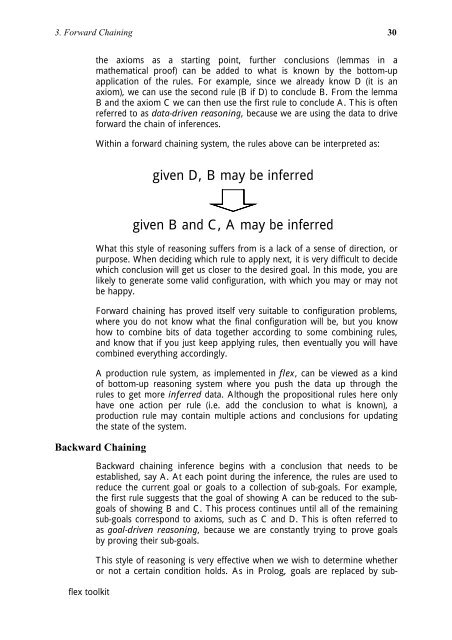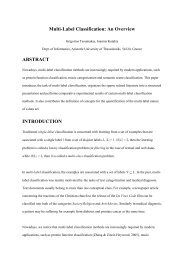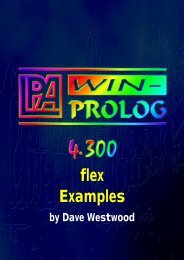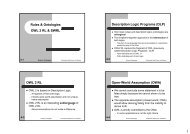You also want an ePaper? Increase the reach of your titles
YUMPU automatically turns print PDFs into web optimized ePapers that Google loves.
3. Forward Chaining 30<br />
the axioms as a starting point, further conclusions (lemmas in a<br />
mathematical proof) can be added to what is known by the bottom-up<br />
application of the rules. For example, since we already know D (it is an<br />
axiom), we can use the second rule (B if D) to conclude B. From the lemma<br />
B and the axiom C we can then use the first rule to conclude A. This is often<br />
referred to as data-driven reasoning, because we are using the data to drive<br />
forward the chain of inferences.<br />
Within a forward chaining system, the rules above can be interpreted as:<br />
given D, B may be inferred<br />
<strong>flex</strong> toolkit<br />
given B and C, A may be inferred<br />
What this style of reasoning suffers from is a lack of a sense of direction, or<br />
purpose. When deciding which rule to apply next, it is very difficult to decide<br />
which conclusion will get us closer to the desired goal. In this mode, you are<br />
likely to generate some valid configuration, with which you may or may not<br />
be happy.<br />
Forward chaining has proved itself very suitable to configuration problems,<br />
where you do not know what the final configuration will be, but you know<br />
how to combine bits of data together according to some combining rules,<br />
and know that if you just keep applying rules, then eventually you will have<br />
combined everything accordingly.<br />
A production rule system, as implemented in <strong>flex</strong>, can be viewed as a kind<br />
of bottom-up reasoning system where you push the data up through the<br />
rules to get more inferred data. Although the propositional rules here only<br />
have one action per rule (i.e. add the conclusion to what is known), a<br />
production rule may contain multiple actions and conclusions for updating<br />
the state of the system.<br />
Backward Chaining<br />
Backward chaining inference begins with a conclusion that needs to be<br />
established, say A. At each point during the inference, the rules are used to<br />
reduce the current goal or goals to a collection of sub-goals. For example,<br />
the first rule suggests that the goal of showing A can be reduced to the subgoals<br />
of showing B and C. This process continues until all of the remaining<br />
sub-goals correspond to axioms, such as C and D. This is often referred to<br />
as goal-driven reasoning, because we are constantly trying to prove goals<br />
by proving their sub-goals.<br />
This style of reasoning is very effective when we wish to determine whether<br />
or not a certain condition holds. As in Prolog, goals are replaced by sub-








